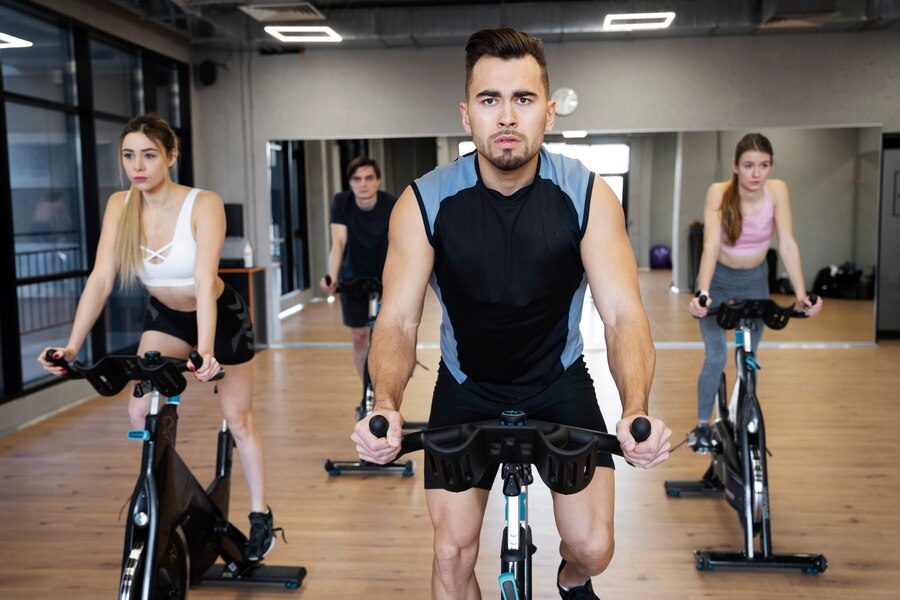Fitness
The Benefits to Spinning: Boost Your Health and Fitness

Spinning, often referred to as indoor cycling, has gained immense popularity over the years. This high-intensity, low-impact exercise offers numerous physical and mental benefits, making it one of the most effective ways to stay fit. Whether you’re new to spinning or a seasoned cyclist, understanding the diverse benefits of spinning can inspire you to incorporate it into your fitness routine. In this article, we’ll explore how spinning can enhance your overall health, burn calories, improve cardiovascular fitness, and boost your mental well-being. We’ll also take a closer look at how it compares to other forms of cardio, and how you can make the most of your spinning sessions.
What is Spinning?
Spinning is a type of indoor cycling that involves riding a stationary bike to music, typically in a group setting, led by an instructor. The workout is designed to simulate outdoor cycling with varying intensities, terrain types, and cadences (the speed at which you pedal). This versatility makes spinning suitable for all fitness levels. The classes are fast-paced, fun, and often involve motivational coaching, making it an engaging and effective way to get fit.
Key Benefits to Spinning
- Burns Calories and Aids Weight Loss
Spinning is one of the best calorie-burning exercises you can do. According to studies, a 45-minute spinning session can burn between 400 to 600 calories, depending on the intensity and effort level. This makes it a highly efficient cardiovascular workout for those looking to lose weight or maintain a healthy weight. The high calorie burn is due to the combination of intense intervals and resistance training during the session, which keeps your metabolism elevated even after the workout is over.
Additionally, as spinning is a form of high-intensity interval training (HIIT), it encourages fat loss, particularly visceral fat, which is the harmful fat stored around your organs. The sustained calorie burn during and after the workout helps promote a leaner physique over time.
- Improves Cardiovascular Health
One of the most significant benefits to spinning is its ability to improve cardiovascular health. Regular spinning workouts help strengthen your heart and lungs, enhancing your body’s ability to deliver oxygen to the muscles. This, in turn, boosts stamina and endurance, making daily activities feel less taxing.
Spinning is an aerobic exercise, meaning it strengthens the heart, reduces the risk of heart disease, and helps lower blood pressure. For those at risk of cardiovascular diseases, spinning provides an excellent way to improve heart health while also reducing the risk of stroke and diabetes.
- Tones and Strengthens Muscles
Spinning is a full-body workout that targets multiple muscle groups. The primary muscles worked during spinning are the quadriceps, hamstrings, calves, glutes, and core. Resistance settings on the bike allow you to increase the intensity and target different muscles, mimicking real-life cycling terrain like hills and sprints.
For those looking to tone their legs and glutes, spinning is especially effective. With its low-impact nature, it builds muscle strength without putting unnecessary stress on the joints, making it ideal for individuals who want to improve muscle tone while avoiding injuries.
- Increases Mental Health and Reduces Stress
Beyond physical fitness, spinning has numerous mental health benefits. The high-intensity workout increases the production of endorphins, the “feel-good” hormones that promote a sense of happiness and well-being. Many spinning enthusiasts report feeling mentally refreshed and energized after a workout, with a significant reduction in stress and anxiety.
Spinning can also help alleviate symptoms of depression. The combination of physical activity and the release of endorphins serves as a natural mood enhancer, helping to combat feelings of low mood and fatigue. Additionally, the group setting and motivating instructor help provide a sense of community, making it a social outlet that boosts emotional health.
- Improves Coordination and Balance
Spinning is not just about pedaling; it also involves upper body movements, such as standing, leaning, and twisting, especially when following the instructor’s rhythm. These movements engage the core and help improve your overall coordination and balance. Over time, regular spinning workouts will help you develop better posture and spatial awareness, making you more agile and balanced in your daily activities.
- Low-Impact Exercise for Joint Health
Unlike running or other high-impact exercises, spinning is a low-impact workout, which makes it ideal for people with joint issues or those recovering from injury. The seated position reduces the impact on your knees and hips while still providing an effective cardio workout. Furthermore, the bike’s resistance can be adjusted to ensure that the workout intensity is suited to your fitness level.
For those who suffer from arthritis or chronic pain, spinning offers a safe and effective way to improve mobility, strengthen muscles, and increase flexibility without exacerbating joint pain.
- Improves Posture and Core Strength
Many people overlook the importance of core strength in their fitness routines, but spinning is an excellent way to target this area. The continuous engagement of the core muscles while cycling, particularly when standing or leaning forward, leads to better posture and overall core strength. A strong core can help reduce the risk of back pain, improve overall athletic performance, and contribute to better posture in everyday life.
- Boosts Endurance and Fitness Levels
One of the most noticeable benefits to spinning is its ability to increase endurance. As you progress in your spinning journey, you’ll notice that your stamina improves, allowing you to pedal for longer periods or at higher intensities without tiring quickly. This boost in endurance carries over into other areas of life, whether it’s playing a sport, hiking, or simply running errands.
Spinning also enhances your overall fitness levels by improving lung capacity, muscle strength, and cardiovascular performance, providing a well-rounded fitness regimen that can complement other forms of exercise, such as strength training or yoga.
Spinning vs. Other Cardio Workouts
To better understand the unique benefits of spinning, it’s helpful to compare it to other popular cardio exercises. Below is a chart comparing spinning with running, swimming, and cycling in terms of calorie burn, muscle engagement, and joint impact.
| Exercise | Calories Burned (per 45 minutes) | Primary Muscles Worked | Impact on Joints |
|---|---|---|---|
| Spinning | 400–600 | Quads, hamstrings, calves, glutes, core | Low (Low-impact) |
| Running | 450–700 | Quads, hamstrings, calves, glutes, core | High (High-impact) |
| Swimming | 400–600 | Full body (upper and lower) | Low (No impact) |
| Cycling (Outdoor) | 400–700 | Quads, hamstrings, calves, glutes, core | Moderate (Depending on terrain) |
As shown in the chart, spinning offers a similar calorie burn to running and swimming, with the added benefit of being low-impact, which makes it a safer option for those with joint concerns. Additionally, unlike swimming or running, spinning can easily be done indoors and doesn’t require access to a pool or running track.
How to Maximize the Benefits of Spinning
To make the most of your spinning sessions, consider these tips:
- Focus on Intensity: To get the best calorie burn and cardiovascular benefits, vary your intensity levels throughout the class. Push yourself during sprints, but also allow for active recovery with slower-paced riding.
- Adjust Your Bike Properly: Make sure your bike is adjusted to fit your body. Proper alignment of the saddle and handlebars will help prevent injury and ensure you’re getting the most out of your workout.
- Hydrate: Spinning can make you sweat a lot, so it’s essential to stay hydrated before, during, and after your workout. Dehydration can lead to fatigue and muscle cramps.
- Consistency is Key: To see the best results, aim for at least 3–4 spinning sessions per week. Like any fitness routine, consistency is crucial to achieving long-term benefits.
Conclusion
Spinning offers a wide array of benefits that make it a great choice for anyone looking to improve their fitness. From burning calories and toning muscles to boosting mental health and improving cardiovascular endurance, the advantages of spinning go far beyond just weight loss. Whether you’re aiming to improve your strength, endurance, or mood, incorporating spinning into your fitness routine is an effective and enjoyable way to achieve your goals.
Fitness
Cold Shower vs. Cold Plunge: Which One Is Right for You?

Ever wondered which cold therapy method packs a bigger punch—cold showers or cold plunges?
Athletes, biohackers, and wellness enthusiasts swear by cold exposure for its benefits, from boosted recovery to mental resilience. But which method delivers better results? And how do you choose the right one for your lifestyle?
In this deep dive, we’ll compare Cold Shower vs. Cold Plunge head-to-head, examining the science, benefits, and practical considerations. By the end, you’ll know exactly which icy ritual belongs in your routine.
Cold Showers vs. Cold Plunges: Key Differences
Before we weigh the pros and cons, let’s define each method:
-
Cold Shower: Standing under cold (50–60°F) water for 1–5 minutes.
-
Cold Plunge: Submerging your body (usually up to the neck) in icy water (40–55°F) for 1–10 minutes.
While both expose you to cold, the intensity and immersion level differ significantly.
The Science Behind Cold Exposure
Cold therapy triggers vasoconstriction (narrowing of blood vessels), reducing inflammation and flushing metabolic waste. It also spikes norepinephrine, a hormone linked to focus and mood.
Studies show cold exposure can:
✅ Reduce muscle soreness (1)
✅ Improve circulation (2)
✅ Boost mental resilience (3)
✅ Enhance immune response (4)
But does a cold shower deliver the same benefits as a full-body plunge?
Cold Showers: The Beginner-Friendly Option
Pros:
✔ Accessible – No special equipment needed.
✔ Gentler – Easier to tolerate for beginners.
✔ Convenient – Fits into daily showers.
Cons:
❌ Less intense – Limited full-body immersion.
❌ Shorter duration – Harder to stay in for long periods.
Best For:
-
Newcomers to cold therapy
-
People seeking a quick energy boost
-
Those with limited space or budget
Expert Tip: Start with 30 seconds of cold at the end of your shower and gradually increase.
Cold Plunges: The Ultimate Cold Therapy
Pros:
✔ Full-body immersion – More effective for recovery (5).
✔ Deeper cold exposure – Stronger metabolic and hormonal response.
✔ Customizable – Adjust temperature and duration.
Cons:
❌ Expensive – Requires a plunge tub or natural cold water source.
❌ Harder to tolerate – Not ideal for beginners.
Best For:
-
Athletes and serious recovery seekers
-
People with chronic inflammation
-
Those committed to long-term cold therapy
Expert Tip: Aim for 3–5 minutes at 50–55°F before progressing to colder temps.
Which One Wins?
| Factor | Cold Shower | Cold Plunge |
|---|---|---|
| Ease of Use | High | Moderate |
| Cost | Free | $100–$5,000+ |
| Effectiveness | Moderate | High |
| Recovery | Good | Excellent |
Verdict:
-
Choose cold showers if you want a simple, daily habit.
-
Opt for cold plunges if you’re serious about recovery and performance.
How to Get Started Safely
For Cold Showers:
-
Finish your normal shower with 30 seconds of cold.
-
Gradually increase to 2–5 minutes.
-
Breathe deeply to manage the shock.
For Cold Plunges:
-
Start with 50–55°F water for 1–2 minutes.
-
Use a timer to avoid overexposure.
-
Warm up naturally afterward (no hot showers immediately).
Warning: Avoid cold exposure if you have heart conditions or Raynaud’s disease.
Final Thoughts: Cold Shower vs. Cold Plunge
Both cold showers and cold plunges offer unique benefits. If you’re testing the waters (literally), start with showers. If you’re chasing peak performance, a cold plunge may be worth the investment.
The best choice? The one you’ll stick with consistently.
Now, over to you—will you brave the cold shower or take the full plunge?
Fitness
Plantar Fasciitis Slippers: Do They Really Help?

Do your feet ache the moment you step out of bed? If you suffer from plantar fasciitis, that sharp heel pain can make mornings miserable. But what if the right pair of slippers could ease your discomfort?
Plantar fasciitis slippers are designed to provide arch support, cushioning, and stability—key elements in relieving foot pain. But do they work? And how do you choose the best pair?
In this guide, we’ll break down:
✔ What makes plantar fasciitis slippers different
✔ Science-backed benefits (do they really help?)
✔ Top features to look for
✔ 5 best slippers for plantar fasciitis in 2024
✔ Expert tips for maximum relief
Let’s dive in.
What Are Plantar Fasciitis Slippers?
Unlike regular slippers, plantar fasciitis slippers are specially designed to:
-
Support the arch (reducing strain on the plantar fascia)
-
Cushion the heel (absorbing shock with every step)
-
Promote proper alignment (preventing overpronation)
Dr. Emily Splichal, a podiatrist and human movement specialist, explains:
“Plantar fasciitis slippers should mimic the support of orthopedic shoes. A contoured footbed and firm heel counter are essential to offload tension on the fascia.”
Who Needs Them?
-
People with chronic heel pain
-
Those recovering from plantar fasciitis
-
Individuals who stand or walk barefoot often
-
Postpartum women (due to relaxin hormone effects on ligaments)
Do Plantar Fasciitis Slippers Really Work?
Research says yes—with caveats.
A 2020 study in the Journal of Foot and Ankle Research found that firm arch support significantly reduces plantar fascia tension. Another study in Clinical Biomechanics showed that heel cushioning decreases impact forces by up to 20%.
But not all slippers are equal.
-
Cheap, flat slippers can worsen pain.
-
Overly soft memory foam lacks support.
-
Non-slip soles are crucial for stability.
Real-World Example:
Sarah, a nurse who spent 12-hour shifts on her feet, switched to supportive slippers at home. “Within two weeks, my morning heel pain dropped by 70%,” she reported.
5 Must-Have Features in Plantar Fasciitis Slippers
1. Firm Arch Support
-
Look for molded EVA or cork footbeds (not just soft foam).
-
Avoid flat slippers—they strain the plantar fascia.
2. Deep Heel Cup
-
Cradles the heel to reduce impact.
-
Prevents lateral instability.
3. Adjustable Straps
-
Ensures a snug fit (loose slippers cause friction).
-
Helpful for swollen feet.
4. Rigid Outsole
-
A slightly stiff sole prevents excessive flexing.
-
Rubber treads prevent slips.
5. Breathable Materials
-
Mesh or leather uppers reduce sweat.
-
Moisture-wicking liners prevent bacteria buildup.
5 Best Plantar Fasciitis Slippers of 2024
1. Oofos OOahh Slide
✅ Podiatrist-recommended
✅ Dual-density foam absorbs shock
✅ Machine washable
Best for: Recovery after workouts
2. Vionic Relax Slipper
✅ Orthotic arch support
✅ Fleece-lined for warmth
✅ APMA-approved
Best for: Cold climates
3. Crocs Classic Clog
✅ Roomy toe box
✅ Cushioned Croslite foam
✅ Easy to clean
Best for: Indoor/outdoor use
4. Hoka Ora Recovery Slide
✅ Meta-Rocker sole reduces strain
✅ Thick midsole cushioning
✅ Lightweight
Best for: Severe heel pain
5. OrthoFeet Asheville Slipper
✅ Adjustable straps
✅ Non-binding design
✅ Wide widths available
Best for: Diabetic neuropathy
Expert Tips to Maximize Relief
-
Wear them immediately after waking (when fascia is tightest).
-
Pair with stretching (calf raises, towel stretches).
-
Replace every 6–12 months (cushioning wears out).
-
Avoid going barefoot (even at home).
Dr. Markinson, NY-based podiatrist, advises:
“Think of plantar fasciitis slippers as a bridge between shoes and barefoot walking. They’re not a cure but a critical part of pain management.”
Final Verdict: Are They Worth It?
If you battle heel pain, morning stiffness, or arch fatigue, plantar fasciitis slippers can be a game-changer. The key is choosing structured support over flimsy fashion slippers.
Try this: Wear supportive slippers for 2 weeks straight (especially first thing in the morning). Track your pain levels—many users report noticeable improvement in that time.
Fitness
Rotisserie Chicken Calories & Grams: A Complete Nutrition Guide

Introduction
Picture this: You’re rushing home after a long day, and the aroma of golden-brown rotisserie chicken fills the air. It’s juicy, convenient, and seemingly healthy—but how many calories are you actually consuming? And what about protein, fat, and serving sizes?
Rotisserie chicken is a go-to meal for busy families, fitness enthusiasts, and health-conscious eaters. But not all chickens are created equal. Depending on seasoning, cooking methods, and portion size, the nutritional value can vary.
In this guide, we’ll break down rotisserie chicken calories per gram, compare different types (plain vs. seasoned), and provide expert-backed tips for making the healthiest choice.
Rotisserie Chicken Nutrition: Calories & Macros
1. Calories in Rotisserie Chicken (Per 100g & Per Serving)
A typical rotisserie chicken (without skin) contains roughly:
-
165–170 calories per 100g (about 3.5 oz)
-
31g protein
-
3.6g fat
-
0g carbs
However, with skin, the numbers change:
-
237–250 calories per 100g
-
23g protein
-
15g fat
Why the difference? The skin adds extra fat and calories—about 50–80 more calories per 100g.
2. Breaking Down a Whole Rotisserie Chicken
An average rotisserie chicken weighs 2–3 lbs (900–1,360g) and yields:
-
Breast (skinless): 284 calories, 53g protein, 6g fat (per ½ breast)
-
Thigh (skinless): 209 calories, 26g protein, 10g fat
-
Drumstick (skinless): 172 calories, 28g protein, 6g fat
-
Wing (with skin): 126 calories, 11g protein, 8g fat
Pro Tip: Removing the skin cuts calories by 20–30%, making it a leaner protein source.
Does Brand Matter? Comparing Store-Bought Rotisserie Chickens
Not all rotisserie chickens are equal. Some stores inject brine (saltwater solution) for juiciness, increasing sodium content. Here’s a quick comparison:
| Brand/Store | Calories (per 100g, no skin) | Sodium (mg per serving) |
|---|---|---|
| Costco | 170 | 460mg |
| Walmart | 165 | 510mg |
| Whole Foods | 160 | 380mg |
Key Takeaway: If you’re watching sodium, opt for organic or low-sodium options.
Rotisserie Chicken vs. Homemade: Which Is Healthier?
Store-bought rotisserie chicken is convenient, but homemade lets you control ingredients.
Pros of Store-Bought:
✅ Ready-to-eat, time-saving
✅ Consistent flavor
✅ Often cheaper than raw whole chicken
Cons of Store-Bought:
❌ Higher sodium (from brining)
❌ Possible additives (preservatives, MSG)
❌ Skin is often oil-basted
Healthier Alternative:
-
Buy a plain rotisserie chicken, remove the skin, and season at home with herbs.
-
Make your own in an air fryer or slow cooker for lower sodium.
How to Use Rotisserie Chicken for Weight Loss & Muscle Gain
For Weight Loss:
-
Remove the skin to save ~80 calories per serving.
-
Pair with veggies (salads, stir-fries) for fiber.
-
Avoid creamy sauces (ranch, gravy) that add empty calories.
For Muscle Gain:
-
Eat the skin for extra calories (if bulking).
-
Combine with complex carbs (brown rice, quinoa).
-
Meal prep shredded chicken for high-protein lunches.
Real-World Example:
A fitness influencer eats rotisserie chicken + sweet potatoes + broccoli post-workout for a balanced 400-calorie meal.
Common Myths About Rotisserie Chicken
Myth 1: “It’s Always Healthier Than Fried Chicken.”
✅ True if skinless—but some rotisserie chickens are basted in oil, making them similar in fat to fried chicken.
Myth 2: “All Rotisserie Chickens Are High in Protein.”
✅ Mostly true, but brined chickens may have slightly less protein per gram due to water retention.
Myth 3: “Organic Rotisserie Chicken Is Always Better.”
✅ Organic = fewer additives, but check sodium levels—some are still high.
Final Verdict: Is Rotisserie Chicken Good for You?
Yes—if you choose wisely! Here’s how:
✔ Pick skinless portions to save calories.
✔ Compare sodium levels (aim for <500mg per serving).
✔ Use leftovers creatively (soups, tacos, salads).
Rotisserie Chicken Calories & Grams is a nutrient-dense, high-protein option—perfect for quick meals without sacrificing health.
Your Next Step: Smart Rotisserie Chicken Hacks
-
Shred & Freeze for easy meal prep.
-
Make Bone Broth with the carcass for extra nutrients.
-
DIY Seasoning to control salt and flavor.
Now that you know the calories, grams, and best practices, you can enjoy rotisserie chicken guilt-free!
-

 Articles3 months ago
Articles3 months agoHow Many Times Can You Regrow Green Onions
-

 News11 months ago
News11 months agoUnderstanding HotLeaks: What You Need to Know
-

 Fashion8 months ago
Fashion8 months agoOpals in the USA: A Gemstone Transforming the Crystal Healing Market
-

 Entertainment8 months ago
Entertainment8 months agoHow to Use Snaptik: A Complete Guide to Download TikTok Videos
-

 Technology1 year ago
Technology1 year agoThe Wonders of Oh Em Gee Blog
-

 Entertainment1 year ago
Entertainment1 year agoBare it All: Unforgettable Skinny Dipping Stories Shared
-

 Health1 year ago
Health1 year agoCan You Smoke Shrooms? Exploring the Myths and Realities
-

 Articles5 months ago
Articles5 months agoWHAT IS THE DIFFERENCE BETWEEN SEED GARLIC AND FOOD GARLIC?
